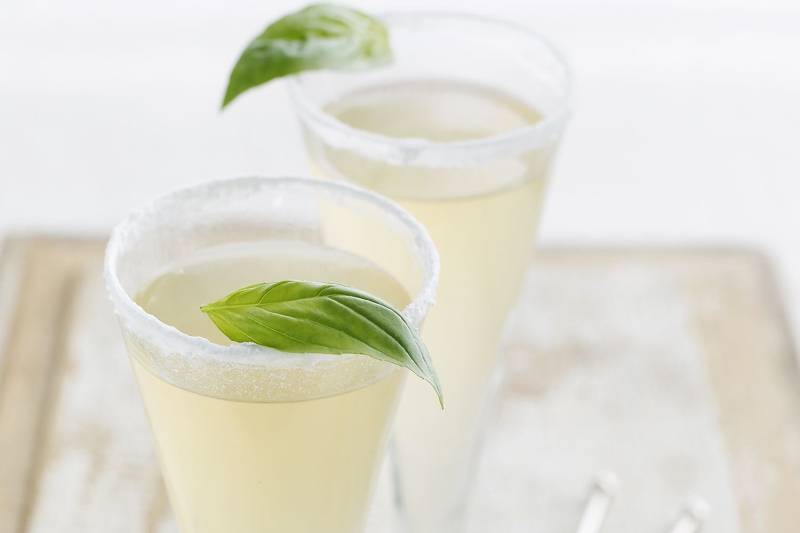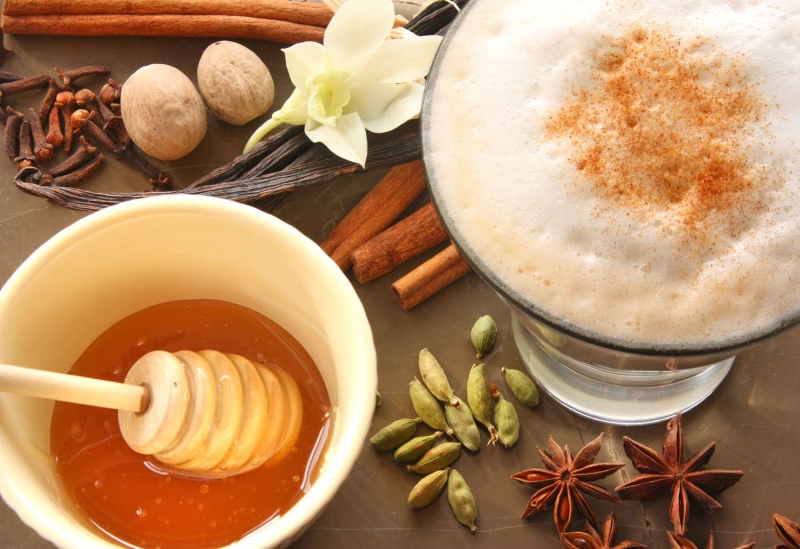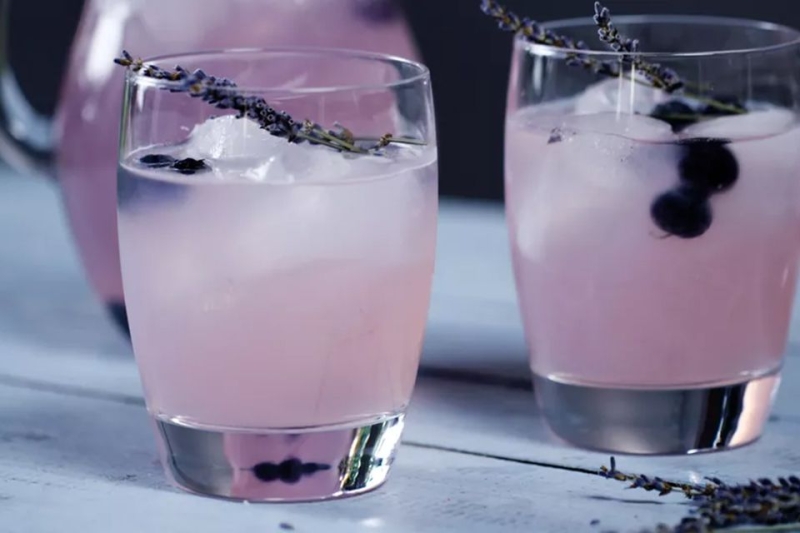Add a Fresh Layer of Flavor to Your Drinks
You know that drinks like the mojito and mint julep require a handful of mint, but it’s not the only herb you can add to drinks. Herbal cocktails are everywhere and a number of spices are perfect drink ingredients as well. Whether it’s basil, lavender, or rosemary from your own garden, or cinnamon sticks you picked up at the market, bringing herbs and spices into your bar opens up a new realm of flavor possibilities.
Getting those flavors into your beverages is not difficult. Quite often, fresh herbs can simply be muddled into the drink. Some drinks recipes require an infusion into vodka, tequila, whiskey, or other distilled spirits. And, you can always add flavor to a sweetener, such as simple syrup. All of these techniques are very easy and you’ll be surprised at how well herbs and spices pair with other flavors to create fascinating drinks.
Basil Cocktails

Basil is a fascinating cocktail ingredient because of it’s semi-sweet, spiced, anise-like flavor. Most often muddled, it’s a perfect companion for gin in recipes like the basil-ica cocktail and green gin giant, both of which feature an elderflower liqueur as well. For a unique taste, the Georgia on my mind pairs the herb with bourbon and peach nectar.
The combination of strawberries and basil should be on everyone’s must-try list. Try the duo against vanilla vodka and hard cider in the Orchard catch cooler.
Homemade basil simple syrup is easy to make and useful. It appears in some tomojito recipes as well as the sparkling strawberry rosé. Taking that a step further, the basil-rosemary orange shandy recipe is a refreshing beer drink made with a more complex syrup.
Cardamom Cocktails

Cardamom is no stranger to drinks, though it’s rare in cocktails. This spice is both sweet and pungent, adding a sort of smoky warmth and almost bittersweet, lemony flavor to drinks. Either the whole pods are infused into warm drinks or crushed for cold ones. Ground (or powdered) cardamom is used as well.
Cardamom is often found alongside other warming spices, including anise, cinnamon, cloves, ginger, orange, and vanilla. Best known for making authentic Turkish coffee and masala chai, it’s a great addition to many coffee cocktails and tea drinks. You’ll also find it in some mulled wine and classic wassail recipes.
This spice is making its way into modern mixology as well. For instance, it’s used to make a cardamom simple syrup that sweetens the spiced pomegranate martini, in which it’s set against pomegranate. Cardamom pods are also muddled with pink peppercorn in an intriguing genever cocktail called the aura in me.
Cinnamon Cocktails

Stock your bar with cinnamon sticks and infuse the warm spice into your cocktails with the bonus of a natural stir stick. Cinnamon’s warm, sweet, woody aroma and flavor is essential for fall and winter drinks and is a key ingredient in the traditional mulling spice mix.
Cinnamon schnapps tastes more like candy, as do other commercial cinnamon-flavored liquors. With a cinnamon stick or two, you can get a natural flavor and make your own infusions. Try cinnamon whiskey, apple-cinnamon tequila, or apple-pear-cinnamon vodka.
Cinnamon simple syrup is easy to make, too. This adds a sweet, spicy flavor to a variety of drinks and is a great sweetener for coffee and tea. For cocktails, it’s paired with blood orange in the almost a collins recipe, candy corn-infused vodka in the children of the corn, and is a key ingredient in this Thanksgiving fall sangria.
A cinnamon stick garnish will slowly infuse more flavor into your drinks. The hot apple toddy and hot buttered rum, as well as apple martinis, pumpkin martinis, and hot cocoa cocktails, are just a few recipes where it can be useful.
Ground cinnamon doesn’t dissolve particularly well, though it is used on occasion. For example, it is shaken into the apple pie martini while the apple crisp cocktail sprinkles it on top as a garnish. You can also mix ground cinnamon with sugar to rim the glass of cocktails like the spiced pumpkin.
Cilantro and Coriander Cocktails

Cilantro and coriander come from the same plant. Cilantro is the fresh leaf (considered an herb) and coriander is the seed (categorized as a spice). Cilantro has a very distinct, pungent flavor, reminiscent of lemony ginger with a hint of sage. A little goes a long way and people either love or hate it.
Cilantro should always be used fresh and is often muddled or blended into drinks. Try it in a sangrita-like two-part shooter called el vocho or add a few leaves to the blender when mixing up a guacarita with fresh avocado and tequila. Cilantro also pairs well with sweet and spicy peppers, citrus fruits, cucumber, lemongrass, mint, and tamarind.
Coriander is often cooked into a syrup for use in recipes like the Coriandrum cocktail. You can also enjoy a coriander-pineapple syrup with pineapple-infused whiskey in the centennial punch recipe. Try mixing it into drinks that include any mulling spices as well as apple, chile pepper, coconut, pear, and tomato.
Ginger Root Cocktails

Ginger is added to countless cocktails in many different forms, including ginger ale, beer, and liqueur. The fresh root adds that signature warm ginger snap and spice to make amazing drinks.
Dials of peeled ginger can be muddled into drinks, including the eye candy cocktail where it’s paired with mint, gin, and elderflower. The ginger snap martini muddles it with molasses and holiday spices.
If you find your ginger beginning to go bad, preserve it in a ginger syrup. Whether it’s a simple ginger lemonade, a pomegranate-ginger martini, or a tea-infused rum cocktail, it’s a great ingredient to have around. You can even use the syrup to make ginger ale or as a substitute for ginger liqueur. Ginger can also be used to make ginger vodka.
Ginger ingredients go well with any liquor, though rum and vodka are the best for fresh ginger. You’ll also want to try it with amaretto, Frangelico, and Drambuie.
Lavender Cocktails

Lavender creates beautiful floral cocktails. The flowers are the most fragrant and flavorful, but the leaves can be used as well. The herb is often muddled to create lovely drinks like the lavender lemon drop martini and the flowers are stunning when frozen into ice cubes.
Most often, this herb is used to make lavender simple syrup. From a luscious and simple lavender martini to the refreshing lavender sapphire collins, it’s an easy way to enjoy the sweetly floral flavor. You can sweeten it up even more with a lavender honey syrup, a key ingredient in the scotch and Drambuie brogue cocktail.
Lavender is a perfect pairing for a variety of berries, including the blueberries found in the Paulista cocktail and daiquir-ease. The garden patch smash adds raspberries to lavender syrup, uses a muddle of fresh blueberries, and is topped off with lavender soda to create the ultimate summer cocktail.
Mint Cocktails

Mint is, by far, the most used and popular herb in cocktails. Much of its fame is attributed to the mojito and mint julep, though its cool, refreshing flavor is a wonderful addition to countless recipes. It pairs well with lime, lemon, and other fruits, as well as basil, chocolate, and ginger.
There are many varieties of mint. Spearmint is the most common and the type you'll most likely encounter packaged in produce markets. It's mellow and refreshing with a pleasantly pungent flavor. Peppermint is also quite popular and has more pronounced menthol notes. Apple, chocolate, lemon, lime, and pineapple mints can add another layer of flavor to drinks as well. You'll likely have to grow your own specialty mints, but it's one of the easiest herbs to keep alive in the garden or containers.
For the majority of cocktails, you'll muddle mint with one of the drink's mixers, such as fruit or syrup. It can be helpful to slap the leaves between your palms to wake up the herb's essence and make it more flavorful. Be sure to save the top cluster of leaves to use as a garnish.
Rum and whiskey are it most common liquor companions. It’s been used for a long time, appearing in classic cocktails like the whiskey smash and rum-based Madison Avenue. In modern renditions of its most famous drinks, mint is paired with a variety of fruits, from a pineapple mojito to a raspberry mojito and a white peach julep to a ginger julep. Mint, along with ginger, also gives an interesting twist to the Manhattan 101 recipe.
You will find mint in tequila cocktails as well. The cucumber mint margarita, for instance, adds mint to the blender, then gives the drink a spicy kick. Vodka and gin are not out of the question, either. Try the former in sparkling shamrock and the latter in a French pearl.
Rosemary Cocktails

Rosemary is as lovely as lavender and the two are often paired together in cocktails. This herb can span the seasons, though. It is just as wonderfully fragrant in the middle of winter as it is on hot summer days. Rosemary has a warm and woody flavor with a peppery floralness that’s unique and inviting.
The herb doesn’t flower often, so the thick, stiff leaves are used. They’re stronger in aroma and flavor, anyway. Rosemary can be muddled or incorporated into a syrup, or infused into liquor. Adding a sprig as a garnish will infuse a drink with flavor or you can burn it to smoke your glass. The smoked rose cocktail is a beautiful example of two of those options.
Rosemary can be used in rum, tequila, vodka, and whiskey recipes. It’s one of the few herbs that can stand up to scotch, too. In the warm months, try it with lavender in a vanilla rose or preggie provençe. If you time it right, rosemary is also really nice with rhubarb and you’ll want to try a rhubarb-rosemary daiquiri in the spring. For cool-weather drinks, the herb is perfect with cranberries. You can mix up a Christmas margarita or try the duo with a generous amount of Grand Marnier in la vie en rouge.
More Herb and Spice Cocktails

Not used as often, these herbs and spices offer intriguing possibilities in cocktails:
Dill: In spite of this herb’s popularity as a pickle seasoning, it can be surprisingly polarizing and you certainly wouldn’t think of it as a stand-out addition to most cocktails. However, its citrusy flavor pairs very well with the Scandinavian favorite, aquavit. Leaning into Nordic flavors, this spin on the classic bloody mary uses dill to complement a base of roasted beets, horseradish, and aquavit.
Eucalyptus: This is definitely not your average cocktail ingredient. It’s pleasantly pungent flavor with strong notes of menthol and citrus is featured in drinks like the Kentucky tea. It’s easiest to add via eucalyptus syrup, which is the signature ingredient in the unique eucalyptus martini.
Lemongrass: The flavor is refreshingly tart, clean, and citrus-like with peppery notes. Most often muddled, lemongrass can double as a straw, though it’s not perfectly functional. Try it in the Soho cocktail or add it to drinks featuring chilies, cinnamon, coconut milk, cucumber, ginger, peach, and pear.
Tarragon: The leaves are sweetly aromatic with hints of pine and anise that pairs surprisingly well with chocolate. It also works with most garden-fresh ingredients like basil and tomato. A syrup can be made from tarragon, or the herb can be muddled as seen in the green giant cocktail. Some drinks, such as the bourbon and blood, simply add it to the shaker while the ruby queen features a sprig as a garnish.
Vanilla Bean: Vanilla is no stranger to the bar, but the fresh vanilla bean is rarely used because the spice is expensive. It does offer a taste of real vanilla which is far more aromatic than vodkas and liqueurs of the flavor. Creating a vanilla simple syrup makes good use of the spice and is a versatile drink sweetener. Some recipes muddle the bean and others, like the raspberry peach cobbler, include it in the shake. In the cafe Brasileiro, it’s infused into heavy cream to top a rich cup of cachaça-spiked coffee.


